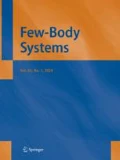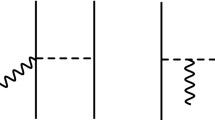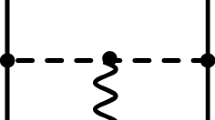Abstract
Recently, we have shown that the continuity equation for the nuclear vector and axial current operators acquires additional terms if the latter depend on the energy transfer. We analyze in detail the electromagnetic single-nucleon four-current operators and verify the validity of the modified continuity equation for all one- and two-nucleon contributions up to fourth order in the chiral expansion. We also derive, for the first time, the leading contribution to the three-nucleon charge operator which appears at this order. Our study completes the derivation of the electroweak nuclear currents to fourth order in the chiral expansion.



Similar content being viewed by others
Notes
The dominant contributions to the single- and two-nucleon operators appear at orders \(Q^{-3}\) and \(Q^{-1}\), respectively. When the nucleon mass m is counted according to \(m \sim \varLambda _b^2/Q\) [21] as done here and commonly employed in few-nucleon studies, see e.g. Refs. [2, 4, 7, 13,14,15,16,17], no corrections to the charge and current operators appear at order \(Q^{-2}\). Thus, the terms LO, NLO, N\(^2\)LO and \(\hbox {N}^3\hbox {LO}\) refer to the contributions at orders \(Q^{-3}\), \(Q^{-1}\), \(Q^{0}\) and Q, respectively. Notice that the authors of Refs. [22,23,24] employ the counting scheme with \(m \sim \varLambda _b\) leading to a different expansion pattern.
The minus sign is missing in Eq. (4.3) of Ref. [29] and for the quantities \(\delta J_{c2, \, c5, \, c6, \, c7}\) in Eq. (4.6) of that paper.
Requiring, in addition to renormalizability of the single- and two-nucleon current operators, also factorizability of the exchanged pions in the three-nucleon charge operator, see [33] for more details, leads to the stronger constraints on the phases, namely \(\bar{\beta }_1 = 1\), \(\bar{\beta }_4 = -1\) and \(\bar{\beta }_5 = \bar{\beta }_6 = -1/2\).
We adopt here the commonly accepted sign convention for the electromagnetic current, which differs from the one used in our paper [33].
References
D.R. Entem, N. Kaiser, R. Machleidt, Y. Nosyk, Phys. Rev. C 91(1), 014002 (2015)
E. Epelbaum, H. Krebs, U.-G. Meißner, Phys. Rev. Lett. 115(12), 122301 (2015)
D.R. Entem, N. Kaiser, R. Machleidt, Y. Nosyk, Phys. Rev. C 92(6), 064001 (2015)
P. Reinert, H. Krebs, E. Epelbaum, Eur. Phys. J. A 54(5), 86 (2018)
D.R. Entem, R. Machleidt, Y. Nosyk, Phys. Rev. C 96(2), 024004 (2017)
A. Manohar, H. Georgi, Nucl. Phys. B 234, 189 (1984)
E. Epelbaum, H. Krebs, U.-G. Meißner, Eur. Phys. J. A 51(5), 53 (2015)
R.J. Furnstahl, N. Klco, D.R. Phillips, S. Wesolowski, Phys. Rev. C 92(2), 024005 (2015)
U. van Kolck, Phys. Rev. C 49, 2932 (1994)
E. Epelbaum, W. Glöckle, U.-G. Meißner, Nucl. Phys. A 747, 362 (2005)
E. Epelbaum, Phys. Lett. B 639, 456 (2006)
S. Ishikawa, M.R. Robilotta, Phys. Rev. C 76, 014006 (2007)
V. Bernard, E. Epelbaum, H. Krebs, U.-G. Meißner, Phys. Rev. C 77, 064004 (2008)
V. Bernard, E. Epelbaum, H. Krebs, U.-G. Meißner, Phys. Rev. C 84, 054001 (2011)
H. Krebs, A. Gasparyan, E. Epelbaum, Phys. Rev. C 85, 054006 (2012)
H. Krebs, A. Gasparyan, E. Epelbaum, Phys. Rev. C 87(5), 054007 (2013)
E. Epelbaum, A.M. Gasparyan, H. Krebs, C. Schat, Eur. Phys. J. A 51(3), 26 (2015)
L. Girlanda, A. Kievsky, M. Viviani, Phys. Rev. C 84, 014001 (2011)
T.S. Park, D.P. Min, M. Rho, Phys. Rep. 233, 341 (1993)
T.S. Park, D.P. Min, M. Rho, Nucl. Phys. A 596, 515 (1996)
S. Weinberg, Nucl. Phys. B 363, 3 (1991)
S. Pastore, R. Schiavilla, J.L. Goity, Phys. Rev. C 78, 064002 (2008)
S. Pastore, L. Girlanda, R. Schiavilla, M. Viviani, R.B. Wiringa, Phys. Rev. C 80, 034004 (2009)
S. Pastore, L. Girlanda, R. Schiavilla, M. Viviani, Phys. Rev. C 84, 024001 (2011)
E. Epelbaum, W. Glöckle, U.-G. Meißner, Nucl. Phys. A 637, 107 (1998)
E. Epelbaum, Eur. Phys. J. A 34, 197 (2007)
E. Epelbaum, H.W. Hammer, U.-G. Meißner, Rev. Mod. Phys. 81, 1773 (2009)
S. Kölling, E. Epelbaum, H. Krebs, U.-G. Meißner, Phys. Rev. C 80, 045502 (2009)
S. Kölling, E. Epelbaum, H. Krebs, U.-G. Meißner, Phys. Rev. C 84, 054008 (2011)
M. Hoferichter, P. Klos, A. Schwenk, Phys. Lett. B 746, 410 (2015)
M. Walzl, U.-G. Meißner, Phys. Lett. B 513, 37 (2001)
J.L. Friar, Phys. Rev. C 60, 034002 (1999)
H. Krebs, E. Epelbaum, U.-G. Meißner, Ann. Phys. 378, 317 (2017)
A. Baroni, L. Girlanda, S. Pastore, R. Schiavilla, M. Viviani, Phys. Rev. C 93(1), 015501 (2016). Erratum: [Phys. Rev. C 93, no. 4, 049902 (2016)] Erratum: [Phys. Rev. C 95, no. 5, 059901 (2017)]
B. Kubis, U.-G. Meißner, Nucl. Phys. A 679, 698 (2001)
M.R. Schindler, J. Gegelia, S. Scherer, Eur. Phys. J. A 26, 1 (2005)
N. Fettes, U.-G. Meißner, M. Mojžiš, S. Steininger, Ann. Phys. 283, 273 (2000). Erratum: [Ann. Phys. 288, 249 (2001)]
D.R. Phillips, T.D. Cohen, Nucl. Phys. A 668, 45 (2000)
N. Fettes, U.-G. Meißner, S. Steininger, Nucl. Phys. A 640, 199 (1998)
L.E. Marcucci et al., J. Phys. G 43, 023002 (2016)
Acknowledgements
This work was supported by DFG (SFB/TR 110, “Symmetries and the Emergence of Structure in QCD”) and the BMBF (Grant No. 05P15PCFN1). Further support was provided by the Chinese Academy of Sciences (CAS) President’s International Fellowship Initiative (PIFI) (Grant No. 2018DM0034) and by VolkswagenStiftung (Grant No. 93562).
Author information
Authors and Affiliations
Corresponding author
Additional information
Publisher's Note
Springer Nature remains neutral with regard to jurisdictional claims in published maps and institutional affiliations.
This article belongs to the Topical Collection “Ludwig Faddeev Memorial”.
Unitary Transformation to Exactly Generate the Off-Shell Single-Nucleon Current in Eq. (2.16)
Unitary Transformation to Exactly Generate the Off-Shell Single-Nucleon Current in Eq. (2.16)
In this appendix we construct a unitary transformation, which generates the off-shell single-nucleon longitudinal current in Eq. (2.16).
In order to see how the nuclear operators are affected by time-dependent unitary transformations, we perform an additional unitary transformation of the kind
where \(v_\mu (x)\) is an external vector source and \(X_\mu (\mathbf {x}\,)\) is some antihermitean operator. The unitary transformation changes the Hamilton operator in the presence of the vector source to
with \(H:=W[0]\). For the vector current operator one obtainsFootnote 4
see [33] for more details, where the operator \(W[v]\) is taken at \(t=0\):
Using
where
we obtain
Thus, choosing
we obtain the off-shell term given in Eq. (2.16). It is important to emphasize that the derivation of Eq. (1.7) does not rely on chiral perturbation theory. No approximations were made to derive this equation (except for neglecting the contributions involving more than a single insertion of the external vector source).
Rights and permissions
About this article
Cite this article
Krebs, H., Epelbaum, E. & Meißner, UG. Nuclear Electromagnetic Currents to Fourth Order in Chiral Effective Field Theory. Few-Body Syst 60, 31 (2019). https://doi.org/10.1007/s00601-019-1500-5
Received:
Accepted:
Published:
DOI: https://doi.org/10.1007/s00601-019-1500-5




